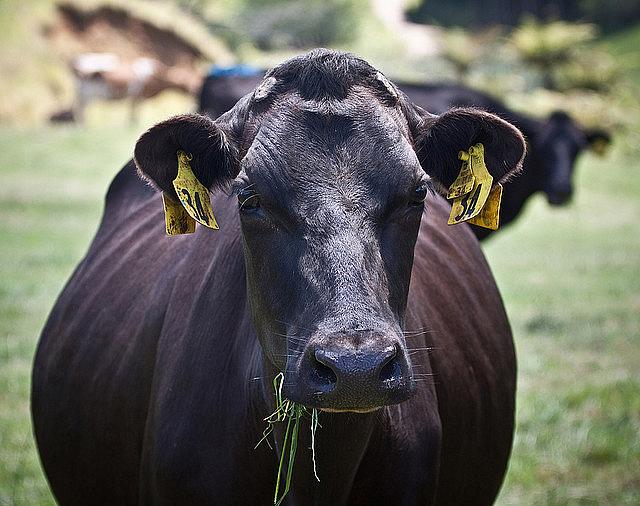Q&A: Reporter amasses evidence of dairies’ threat to water supply (Part 2)

Dairy cows produce milk, and lots of manure.
When a judge ruled recently that dairies had to do a better job of containing the manure they produce, the ruling could be traced back to reporting by Leah Ward of the Yakima Herald. Her work won several awards and accolades, including a special citation from the Knight-Risser Prize for Western Environmental Journalism. Below is the second part of my interview with Ward about her excellent reporting on polluted well water in Washington’s Yakima Valley, which she produced as her project for the National Health Journalism Fellowship. (Read Part One.)
Q: How did the USC Annenberg National Health Journalism Fellowship help you pursue the project?
A: All sorts of ways. Understanding health disparities was one of the most important topics the fellowship introduced me to. I also asked experts and other fellows about whether we should do our own well-water testing and decided that would be time-consuming and costly. I corresponded with senior fellow Martha Shirk several times during the reporting and writing, getting her valuable guidance on structuring the stories. She also steered me clear of drawing conclusions I couldn’t back up. When you are neck deep in data, that can happen.
Q: What were the records that you gathered to report your story and who were some of your key expert sources?
A: I did a lot of records requests, from emails and memos to studies and reports. I had cartons piled up at my desk. Key was one memo in particular from a high-ranking Washington state Department of Ecology hydrologist who basically took his agency to task for sweeping the problem under the rug for too many years. He became a good source, as did a retired scientist who performed a sophisticated well-water analysis. The more I dug, the more sources appeared to help me. That was amazing.
Q: How did you work on this incredibly complex series and at the same time continue to work at your regular job?
A: I spent almost the entire summer of 2008 working exclusively on the series, thanks to my editors. I was pulled off on occasion when they couldn’t help it, but by-and-large they left me alone, and I know Barb Serrano had a lot to do with that. She was a reporter’s editor. Sadly, we lost her to the legal profession!
Q: Were the dairies themselves helpful during your reporting or did you find it hard to get access to them or even to get people to talk with you?
A: They were helpful to a point. Their trade association leader, the Washington State Dairy Federation, based on the west side of the state, came over and we toured a big dairy. But their explanation for the groundwater pollution was always that it was multi-sourced and could not be traced primarily to dairies despite the millions of gallons of manure they produce a year. They held to this party line for years, until the recent stipulation to line their lagoons. The evidence was just too difficult to refute.
Q: What was the reaction from the dairies when you started to publish stories?
A: Well, it was muted in some ways. The industry has never been very receptive to the press. They did not stop talking to me altogether, but their tone definitely changed to one of defensiveness. And they complained to leaders in the business community and to the publisher that I was out to get them, that I never wrote about the good things they were doing, etc. An EPA manager in Seattle told me they were planning a campaign to discredit me, but that never happened.
Q: How have others in the community responded to the series?
A: The environmentalists credit the series with reviving their decade-long effort to get the EPA to take enforcement action via the Safe Drinking Water Act. I also heard from the medical community, particularly in the Lower Yakima Valley. They see first-hand the health disparities of the rural poor, and they suspect nitrates are the canary in the coal mine. We are now learning about bovine hormones and antibiotics in the water, with all sorts of health implications. We’ve also had a cluster of anencephaly, which some very preliminary research has linked to nitrates in drinking water.
Q: You are now going on seven years of writing follow-ups to your original piece. Did you ever imagine that this reporting would evolve over such a long period of time?
A: I would never underestimate Charlie Tebbutt, the Oregon attorney representing Helen Reddout, the Lower Yakima Valley activist who has made this her life’s work. Or Helen herself, for that matter. They are pit bulls. But no, I did not think the series would have such long legs. It’s interesting that the series you reported in the late 1990s with Jennifer Hieger accurately portrayed the dairy manure problem as hidden along backcountry roads. And I described the wells as “hidden” in my title to suggest the Latino population affected has been largely been kept out of sight and out of mind by the powers-that-be. But this many years later, the manure problem is very much out in the open and widely understood. It’s difficult to hide more than 100 million gallons of manure a year.
Photo by Dave Young via Flickr.

